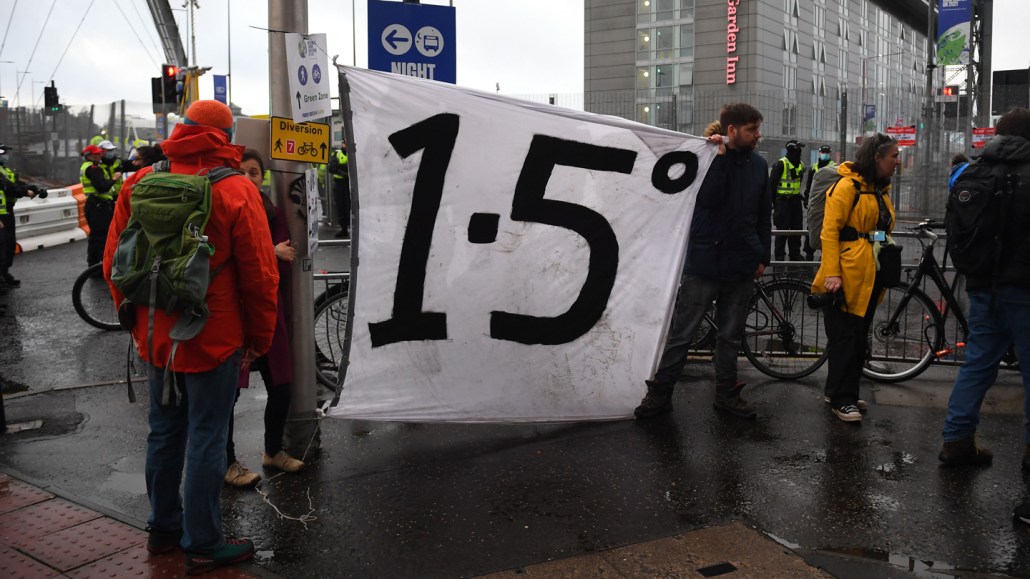
A protestor holds a “1.5 degrees” sign outside the United Nations COP26 Climate Change Conference in Glasgow, Scotland, on November 12. One stated goal of the conference was to keep a global warming limit of 1.5 degrees Celsius by 2100 “within reach.”
Andy Buchanan/AFP/Getty Images
- More than 2 years ago
What’s in a number? The goals of the 2021 United Nations’ climate summit in Glasgow, Scotland, called for nations to keep a warming limit of 1.5 degrees Celsius “within reach.” But when it comes to communicating climate change to the public, some scientists worry that too much emphasis on a specific number is a poor strategy.
Focusing on one number obscures a more important point, they say: Even if nations don’t meet this goal to curb global climate change, any progress is better than none at all. Maybe it’s time to stop talking so much about one number.
On November 13, the United Nations’ 26th annual climate change meeting, or COP26, ended in a new climate deal, the Glasgow Climate Pact. In that pact, the 197 assembled nations reaffirmed a common “ideal” goal: limiting global warming to no more than 1.5 degrees C by 2100, relative to preindustrial times (SN: 12/17/18).
Holding temperature increases to 1.5 degrees C, researchers have found, would be a significant improvement over limiting warming to 2 degrees C, as agreed upon in the 2015 Paris Agreement (SN: 12/12/15). The more stringent limit would mean fewer global hazards, from extreme weather to the speed of sea level rise to habitat loss for species (SN: 12/17/18).
The trouble is that current national pledges to reduce greenhouse gas emissions are nowhere near enough to meet either of those goals. Even accounting for the most recent national pledges to cut emissions, the average global temperature by 2100 is likely to be between 2.2 and 2.7 degrees C warmer than it was roughly 150 years ago (SN: 10/26/21).
And that glaring disparity is leading not just to fury and frustration for many, but also to despair and pervasive feelings of doom, says paleoclimatologist Jessica Tierney of the University of Arizona in Tucson.
“It’s something I’ve been thinking about for a while, but I think it was definitely made sort of more front and center with COP,” Tierney says. She describes one news story in the wake of the conference that “mentioned 1.5 degrees C, and then said this is the threshold over which scientists have told us that catastrophic climate change will occur.”
The article reveals a fundamental misunderstanding of what the agreed-upon limit really represents, Tierney explains. “A lot of my students, for example, are really worried about climate change, and they are really worried about passing some kind of boundary. People have this idea that if you pass that boundary, you sort of tip over a cliff.”
The climate system certainly has tipping points — thresholds past which, for example, an ice sheet begins to collapse and it’s not possible to stop or reverse the process. But, Tierney says, “we really should start communicating more about the continuum of climate change. Obviously, less warming is better.” However, “if we do blow by 1.5, we don’t need to panic. It’s OK if we can stop at 1.6 or 1.7.”
Tierney notes that climate communications expert Susan Hassol, director of the Colorado-based nonprofit Climate Communication, has likened the approach to missing an exit while driving on the highway. “If you miss the 1.5 exit, you just slow down and take the next one, or the next one,” Tierney says. “It’s still better than hitting the gas.”
Target numbers do have some uses, notes climate scientist Joeri Rogelj of Imperial College London. After decades of international climate negotiations and wrangling over targets and strategies, the world has now agreed that 1.5 degrees C of warming is a desirable target for many countries, says Rogelj, who was one of the lead authors on the Intergovernmental Panel on Climate Change’s 2018 special report on global warming.
A global temperature limit “is a good proxy for avoiding certain impacts,” he adds. “These numbers are basically how to say this.”
But Rogelj agrees that focusing too much on a particular number may be counterproductive, even misleading. “There is a lot of layered meaning under those numbers,” he says. “The true interests, the true goals of countries are not those numbers, but avoiding the impacts that underlie them.”
And framing goals as where we should be by the end of the century — such as staying below 1.5 degrees C by the year 2100 — can give too much leeway to stall on reducing emissions. For example, such framing implies the planet could blow past the temperature limit by mid-century and rely on still-unproven carbon dioxide removal strategies to bring warming back down in the next few decades, Rogelj and colleagues wrote in 2019 in Nature.
Banking on future technologies that have yet to be developed is worrisome, Rogelj notes. After all, some warming-related extreme events, such as heat waves, are more reversible than others, such as sea level rise (SN: 8/9/21). Heat wave incidence may decrease once carbon is removed from the atmosphere, but the seas will stay high.
Rogelj acknowledges that it’s a challenge to communicate the urgency of taking action to reduce emissions now without spinning off into climate catastrophe or cliff edge narratives. For his part, Rogelj says he’s trying to tackle this challenge by adding a hefty dose of reality in his scientific presentations, particularly those aimed at nonscientists.
He starts with pictures of forest fires and floods in Europe from 2021. “I say, ‘Look, this is today, 1.1 degrees warmer than preindustrial times,’” Rogelj explains. “‘Do you think this is safe? Today is not safe. And so, 1.5 won’t be safer than today; it will be worse than today. But it will be better than 1.6. And 1.6 won’t be the end of the world.’ And that kind of makes people think about it a bit differently.”







